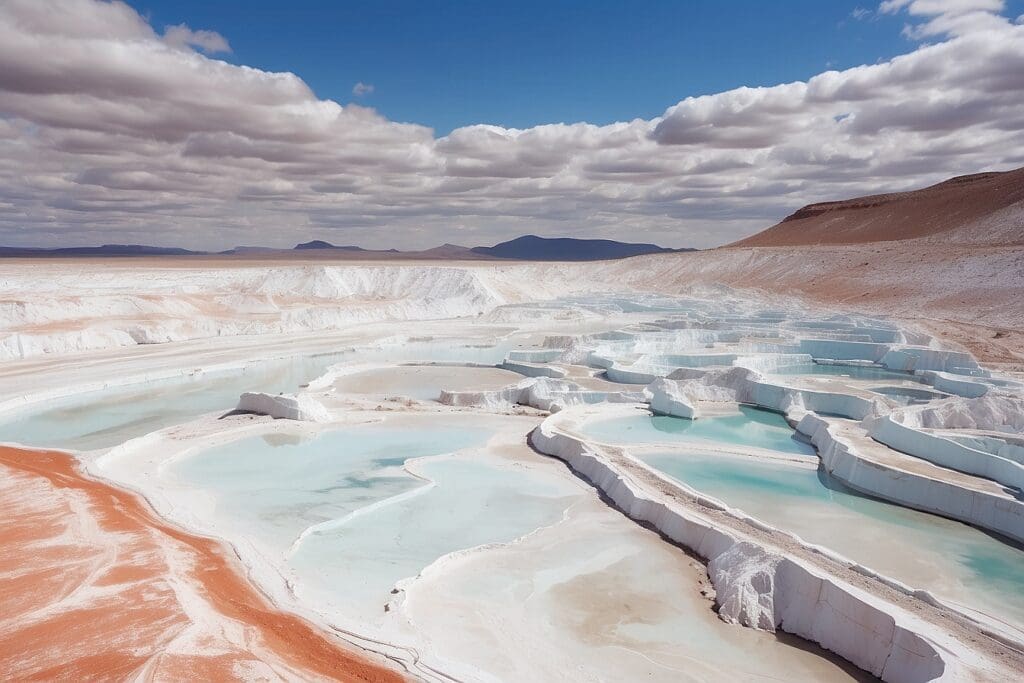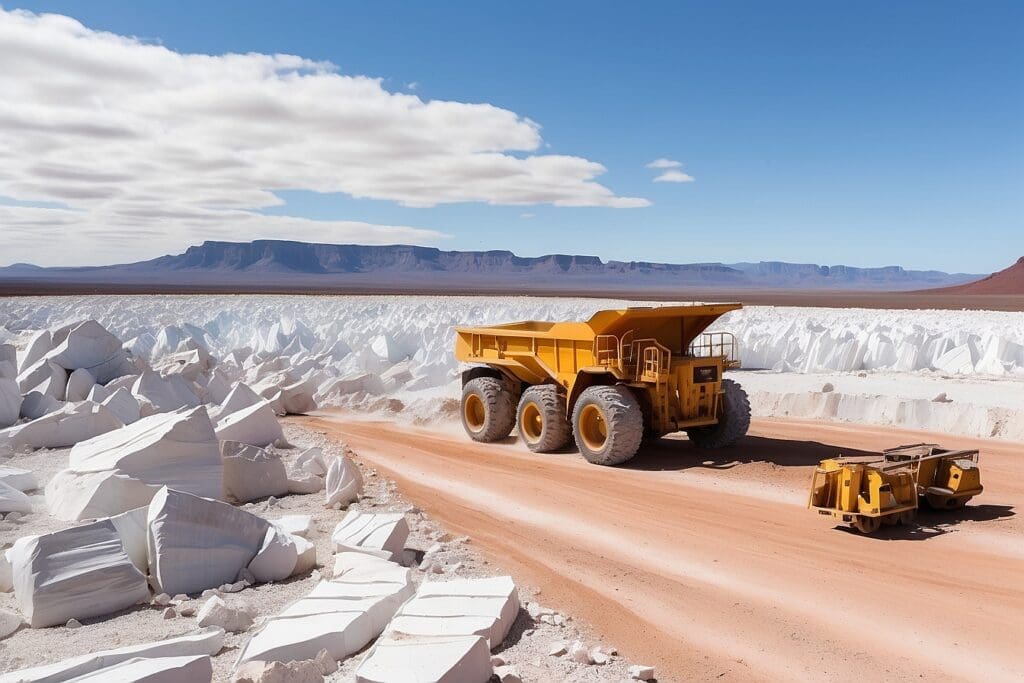In recent years, it seems that the lightest of the metals—Lithium (Li)—is getting more attention than the precious metals. Lithium has become increasingly popular due to its ability to store lots of energy in a small lightweight package: the lithium-ion battery. In the 1990’s, lithium started being used commercially in batteries and has grown steadily in popularity ever since. Lithium products currently power around 90% of laptop computers, more than 60% of mobile phones, military/defense products, NASA’s Mars explorer at night, and show a large potential for growth in battery-powered vehicles such as hybrids and plug-ins. The global market for lithium batteries has increased at annual rates of more than 20% over the past few years, and the investment adviser for Byron Capital Markets predicts a 40% increase in demand for lithium from 2009 to 2014, “We believe that demand is slated to rise dramatically.” So where is all of this lithium coming from?
Extraction: Lithium currently originates from two sources—Brines and Minerals
Brines: Brine is defined as water that is saturated, or nearly saturated with salt, and in this case, the salt is lithium carbonate. Until recently, lithium carbonate was used to treat the manic phase of bipolar disorder, and little else. However, with the increasing demand for lithium in battery technologies, large brine deposits are viewed more like mines than salt flats. To extract lithium, the brines are pumped into a series of evaporation ponds, which crystallizes other salts and leaves a lithium-rich solution. This solution is further processed to remove impurities before conversion to either lithium carbonate or lithium chloride, which is then sold for usage in the chemical or technical industry. Over two-thirds of global lithium production comes from lithium brines in an area of the Andes Mountains encompassing parts of Argentina, Chile and Bolivia—often referred to as the “Lithium Triangle.”
Minerals: Lithium can be contained within hard rock minerals as well. Typically, ideal minerals, such as spodumene, contain around 1-1.5% lithium oxide. Once extracted, the lithium mineral ore is crushed and put through a number of separation processes that improve the lithium concentration by removing unwanted materials. Different separation processes produce varying degrees of lithium content, which, again, is utilized in either chemical or technical markets. The Greenbushes mine in western Austrailia, owned by Talison Minerals, produced 70% of global mineral supply and 23% of the global lithium production in 2008.
The Rising Demand for Lithium—Electric Vehicles

Increasing global demand for electric vehicles will likely be responsible for increased lithium demand as well. What is difficult to predict, is just how quickly demand for electric vehicles will rise. Electric vehicles can be grouped into three main categories:
- Hybrid Electric Vehicle (HEV): a combination of electric power and gasoline engine. Hybrid electric vehicles come in two variants: (i) the mild hybrid electric vehicle which uses a battery pack to supplement the gasoline engine either during acceleration, when the vehicle is at rest, or at low speed driving, and (ii) the full hybrid electric vehicle which allows the car to be propelled in full electric mode and regenerative braking recharges the batteries. Hybrid electric vehicles consume approximately 0.5-2 kg Li per vehicle.
- Plug-in Hybrid Electric Vehicles (PHEV): allow batteries to be recharged by plugging the vehicle into an electric system. Plug-in hybrid electric vehicles consume approximately 1.8-4.2 kg Li per vehicle.
- Electric Vehicles (EV): fully electric vehicles whose main propulsion mode is electric, but may also have a small gasoline engine to either assist in recharging the batteries or provide power to the engine if the battery charge is depleted. Electric vehicles consume approximately 10-20 kg Li per vehicle.
For comparison: most laptop lithium-ion batteries contain around .008 kg of lithium.
Again, gauging demand for electric vehicles is a challenge, but with encouragement from international governments and consumer demand, an electric vehicle market seems quite likely. The U.S. Government announced funding of $2 billion in grant money for battery makers, automakers, and suppliers, with the goal getting one million plug-in hybrid electric vehicles/electric vehicles on the road by 2015. The estimated growing demand for lithium-ion batteries in the auto industry is apparent in the following graphic.
Global Supply and Demand: Lithium carbonate is traded as a bulk mineral, like iron ore. So, unlike “base metals”—such as copper, gold, and silver—lithium is not exchange traded and has no futures contract. Transactions are contract based, and there isn’t much transparency in global pricing. These facts make it difficult to monitor the “value” of lithium through the years, but due to the small number of companies that hold such a large stake in the lithium market, one can get a glimpse into supply and demand.
The global production of lithium is around 20,000 tonnes, most of which is in Australia and Chile. The global lithium reserves have been estimated at 160,000,000 tonnes. On the demand side, the consulting firm Pike Research estimates that the global market for lithium-ion batteries could grow from $877 million this year to $8 billion by 2015. The U.S. Geological Survey (USGS) data show that in recent years, Chile has produced two-thirds of the lithium imported into the United States, with virtually all of the rest coming from Argentina and only 1% coming from China. Nearly half of the world’s lithium reserves are found in Boiliva, but due to increasing nationalist sentiment and its unstable political nature, it is unlikely that the U.S. will be able to successfully trade with the country in the near future. With 77% of the world’s lithium production, the top four producing companies have extraordinary market power.
Lithium Shortage? Some are concerned that with increasing demands for electric vehicles, the world’s lithium reserves will be depleted more rapidly than new lithium can be discovered. This accounts for the increasing interest in lithium exploration—but we need to realize that while demand for lithium will likely continue to increase, catastrophic shortages are not likely. Brian Jaskula, a USGS mineral commodities specialist, said that in the short term, “lithium supplies will be adequate for vehicle demand if EVs take off. And over time horizons of more than 20 years, [] mineral production would rise to meet demand and battery recycling would come into balance with the use of virgin materials.” Just a note—up to 50% of the lithium in used batteries may be recycled in the future. This is not to say that imbalances between supply and demand are not possible in 20 years or so, if EVs really take off in popularity. However, Jaskula notes, “current production is dwindling but exploration is taking place at a furious pace,” so if one takes future discoveries and the potential of recycling old lithium batteries into account, serious shortages are not likely.
Wild Cards: There are several nations to keep an eye on when considering the future of lithium. China, Bolivia, and Afghanistan all have enormous reserves of lithium, but have yet to embrace their production potential. It is difficult to estimate just how much lithium is hidden in these countries because production is presently so low, but many speculate that massive reserves of lithium in countries like Bolivia (estimated to hold half of the world’s reserves), could alter their economies and trade practices forever. China claims it ranks third world-wide in terms of salt-lake brine lithium reserves and fourth in terms of lithium ore resources. However, strained trade relations between the U.S. and China could lead the U.S. elsewhere for lithium. Bolivia is still attempting to sort out its best course of action. International companies are frantically trying to convince the Bolivian government to allow them access to the reserves, but nationalization of the mineral industry looks more likely. Furthermore, the U.S. recently discovered huge mineral deposits in Afghanistan–estimated at nearly one trillion dollars in untapped minerals. Some believe that Afghanistan could become the “Saudi Arabia of lithium.” However, with virtually no mining industry or infrastructure in place today, it may take Afghanistan decades to utilize its mineral reserves effectively.
The Lithium Low Down: There is a great deal of speculation and uncertainty in the lithium market at this point, but if demand for electric vehicles rises as quickly as some estimate, demand for lithium will undoubtedly follow. Issues that typically develop with mineral extraction should be monitored carefully going forward. The U.S. should focus on getting its lithium in the most humane and environmentally conscious manner possible. Demand may pass supply at some point, but if we plan accordingly, we should be able to accommodate these spikes. Emphasizing sustainability by purchasing lithium from neighboring countries (reducing shipping around the world) and focusing on recycling old lithium batteries will reduce environmental degradation and will offset potential shortages in supply. While lithium is poised to become the next copper, if we learn from past mistakes, we can mitigate the damage to our natural world and fellow humans.





